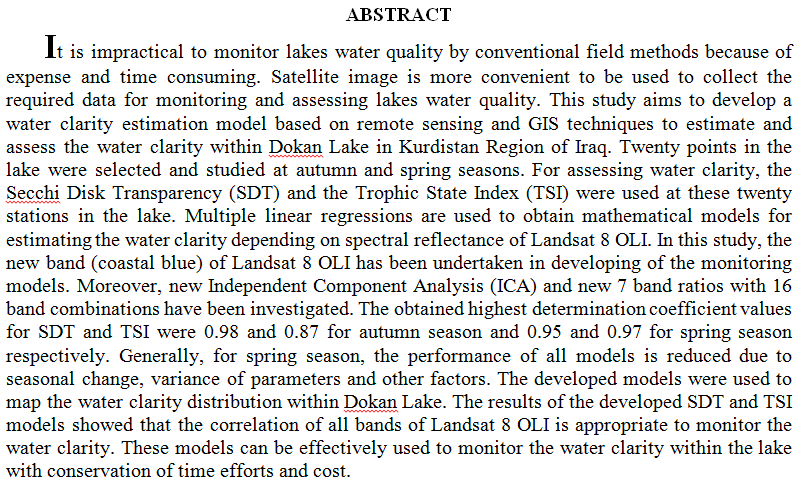
Objectives: To determine the (QoL) for patients with permanent pacemaker and to find-out the relationship between
these patients’ (QoL) and their sociodemographic characteristics such as age, gender, level of education, and
occupation.
Methodology: ٨ purposive non-probability” sample of (62) patient with permanent pacemaker was involved in this
study. The developed questionnaire consists of (4) parts which include !.demographic data form, 2.disease-related
information form, 3.socioeconomic data form, and 4.Permanent pacemaker patient’s quality of life questionnaire data
form. The validity and reliability of the questionnaire were determined through the application of a pilot study. ٨
descriptive statistical a
Objective: to assess the risk factors of coronary artery disease patients.
Methodology: A non-probability (purposive) sample of (100) patients. The study population consisted of
a sample of adults from both genders whose ages were 30 years and more, and was newly diagnosed as
having CAD by coronary angiography in the cardiac catheterization unit of An Nasiriyah heart center.
Results: The result of the study showed that the most common modifiable risk factors were low HDL-C
levels (58%), smoking (53%), hypertension (46%), diabetes mellitus (34%), obesity (30%), high
triglycerides (19%), hypercholesterolemia (17%), and high LDLC (14%). All these factors were positively
and significantly associated with the development
Objective(s): to assess the factors which are associated with the prolonged prehospital delay of patients with
acute myocardial infarction.
Methodology: A descriptive study was conducted at the Coronary Care unit (CCU) in Al-Yarmok Teaching
Hospital, Ibn AL-Nafis Hospital for Cardiovascular Diseases, AL-Kadumia Teaching Hospital, Baghdad Teaching
Hospital, and AL-Kindy Teaching Hospital during the period of the study from February 2
nd
, 2009 to October 30th
,
2009. A random sample of (160) paƟent who were admiƩed to the hospitals were selected one by one. A
questionnaire was constructed for the purpose of the study, which is comprised of four parts that include (1)
sociodemographic data; (2) prehospital d
Water pollution is one of the global challenges that the society must address in the 21st century aiming to improve the water quality, reduce human pollutants and ecosystem health impacts. In phytotoxicity test, the plant of Iresine herbstii was exposed to remove nickel from simulated wastewater using two different ratios (mass of plant to the mass of nickel) (,Rp/Ni) for 21 days with sub-surface batch system. During the exposure period, the removal of Ni concentrations (2, 5 and 10 mg/L) for two mass ratio (2,800 and 34,000) were (83.6%, 77.2%, 78.0%) and (86.8%, 97% and 95.6%), respectively. final result of the rate was found that the highest removal occurred, 97%, at a mass ratio of 34,000 and
... Show More (6)
(6)
 (5)
(5)
Granular carbon can be used after conventional filtration of suspended matter or, as a combination of filtration - adsorption medium. The choice of equipment depends on the severity of the organic removal problem, the availability of existing equipment, and the desired improvement of adsorption condition.
Design calculations on dechlorination by granular - carbon filters considering the effects of flow rate, pH , contact time, head loss and bed expansion in backwashing , particle size, and physical characteristics were considered assuming the absence of bacteria or any organic interface .
 (12)
(12)
 (8)
(8)
The Disi water samples were collected from different Disi aquifer wells in Jordan using a clean polyethylene container of 10-liter size. A hyper-pure germanium (HPGe) detector with high- resolution gamma-ray spectroscopy and a low background counting system was used for the identification of unknown gamma-rays emitting from radionuclides in the environmental samples. The ranges of specific activity concentrations of 226Ra and 228Ra in the Disi aquifer water were found to be from 0.302 ± 0.085 to 0.723 ± 0.207 and from 0.047 ± 0.010 to 0.525 ± 0.138 Bq L−1, with average values of 0.516 ± 0.090 and 0.287 ± 0.091 Bq L−1, respectively. The average combined radium (226Ra + 228Ra) activity and radium activity ratio (228Ra/226Ra) in Disi
... Show More (2)
(2)
This research studies the influence of water source on the compressive strength of high strength concrete. Four types of water source were adopted in both mixing and curing process these are river, tap, well and drainage water (all from Iraq-Diyala governorate). Chemical analysis was carried out for all types of the used water including (pH, total dissolved solids (TDS), Turbidity, chloride, total suspended solid (TSS), and sulfates). Depending on the chemical analysis results, it was found that for all adopted sources the chemical compositions was within the ASTM C 1602/C 1602M-04 limits and can be satisfactorily used in concrete mixtures. Mixture of high strength concrete for compressive strength of (60 MPa) was designed and checked using
... Show More